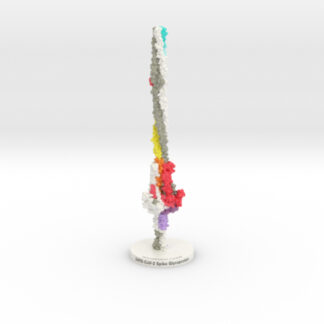Description
Model Description
This is a 3D printed Biologic Model of PROTAC MZ1 in complex with Brd4 and pVHL. This model is printed in multicolor-transparent plastic to visualize the internal ribbon structure of Brd4 (purple) and pVHL (transparent plastic with multi-colored ribbons) while showcasing how PROTACT, yellow, binds to both. This model is designed and printed to assemble and disassemble.
Please note, each 3D print requires an initial setup fee of $400. Please contact us to request bulk discounts.
PubMed Abstract
Inducing macromolecular interactions with small molecules to activate cellular signaling is a challenging goal. PROTACs (proteolysis-targeting chimeras) are bifunctional molecules that recruit a target protein in proximity to an E3 ubiquitin ligase to trigger protein degradation. Structural elucidation of the key ternary ligase-PROTAC-target species and its impact on target degradation selectivity remain elusive. We solved the crystal structure of Brd4 degrader MZ1 in complex with human VHL and the Brd4 bromodomain (Brd4BD2). The ligand folds into itself to allow formation of specific intermolecular interactions in the ternary complex. Isothermal titration calorimetry studies, supported by surface mutagenesis and proximity assays, are consistent with pronounced cooperative formation of ternary complexes with Brd4BD2. Structure-based-designed compound AT1 exhibits highly selective depletion of Brd4 in cells. Our results elucidate how PROTAC-induced de novo contacts dictate preferential recruitment of a target protein into a stable and cooperative complex with an E3 ligase for selective degradation.


